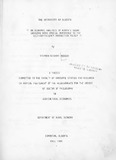| dc.contributor.author | Mbogoh, Stephen G | |
| dc.date.accessioned | 2013-05-27T13:17:48Z | |
| dc.date.available | 2013-05-27T13:17:48Z | |
| dc.date.issued | 1980 | |
| dc.identifier.citation | Mbogo, S. G(1980).An economic analysis of Kenya's sugar industry with special reference to the self- sufficiency production policy | en |
| dc.identifier.uri | http://erepository.uonbi.ac.ke:8080/xmlui/handle/123456789/26270 | |
| dc.description | PhD Thesis | en |
| dc.description.abstract | The objectives of the study included: (i) determination of demand
and supply functions for sugar and assessment of the structure and
general behaviour of the sugar industry; (ii) evaluation of the
performance of the sugar industry in relation to the self-sufficiency
policy; (iii) prediction of future developments of the sugar industry in
relation to the self-sufficiency policy; and (iv) formulation of market
improvement proposals that could find useful applications in the sugar
industry. These objectives are stated in relation to Kenya's sugar
industry.
Relevant data were obtained and analysed using relevant analytic
models and statistical procedures. The hypotheses based on the stated
objectives were then tested. The results of these hypothesis tests in
relation to Kenya's sugar industry were:
(i) Changes in cane and sugar prices have a significant impact
on cane and sugar production;
(ii) Increases in the prices of competitive products, especially
with regard to maize prices, have an adverse effect on cane and sugar
production;
(iii) Changes in the level of sugar price and national disposable
income have a significant impact on sugar consumption;
(iv) Domestic price of sugar is positively correlated to the
world market price of sugar;
(v) The lag in adjusting cane and sugar production to desired
levels following changes in cane and sugar prices is statistically
significant;
(vi) The Government policy has not been effective in relation to
achieving the self-sufficiency goal within the 1966-1976 target period;
(vii) Kenya is likely to become self-sufficient in sugar during
the next decade.
The performance of the sugar industry is thus found to be
unsatisfactory from the self-sufficiency norm, although the performance
is considered to be satisfactory from the (i) stability of prices,
employment and output, and (ii) labour relations criteria. An important
conclusion of the study is the fact that both production and consumption
of sugar are sensitive to economic factors. Price and income elasticities
are found to be low, although the results are comparable to those obtained
from studies on sugar industries in other parts of the world. Therefore,
the use of a sugar pricing policy to influence production and consumption
in order to achieve a self-sufficiency status would likely lead to a high
consumer price and take a relatively long time to achieve its objectives.
Such a policy is considered socially inequitable.
This study recommends an alternative sugar policy that is likely
to lead to self-sufficiency while maintaining a sugar price that is
considered more socially equitable. The recommendations involve (i) the
indexation of the current domestic sugar price to the fluctuations in the
world market price of sugar, and (ii) the operation of a price-support
fund from which the Government is to subsidize domestic sugar production
only when the average production cost exceeds the indexed domestic sugar
price. These recommendations are considered equitable in the sense that
they do not disrupt the established production pattern, yet they result
in a fair price to consumers because there is no longer a need to increase
the sugar price just for the sake of giving a price incentive to producers. | en |
| dc.language.iso | en | en |
| dc.subject | Economic analysis | en |
| dc.subject | Sugar industry | en |
| dc.subject | Self sufficient production | en |
| dc.subject | Policy | en |
| dc.title | An economic analysis of Kenya's sugar industry with special reference to the self- sufficiency production policy | en |
| dc.type | Thesis | en |
| local.publisher | Department of Agricultural Economics, University of Nairobi, Kenya | en |

